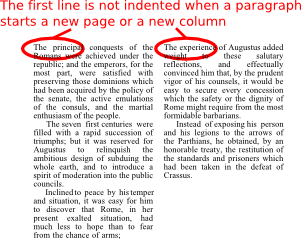Status of this Document
This section describes the status of this document at the time of its publication. Other documents may supersede this document. A list of current W3C publications and the latest revision of this technical report can be found in the W3C technical reports index at http://www.w3.org/TR/.
This is a First Public Working Draft of "Extensible Stylesheet Language (XSL) Requirements Version 2.0" which is expected to become a Working Group Note.
The XSL WG has provided a unique opportunity to provide feedback to the working group through a W3C Requirements
Survey found at
http://www.w3.org/2002/09/wbs/1/xslfo20requirements/
. Please take the time to fill out the survey and help us understand your priorities for the next release of XSL
formatting objects. Additional comments and feedback on individual requirements should be provided using the
W3C public Bugzilla system
. If access to the bugzilla system is not feasible, you may send your comments to
xsl-editors@w3.org
. Each bugzilla entry and email message should contain only one error report. It will be very helpful if you
include the string [FO2.0Req] in the subject line of your report, whether made in Bugzilla or in email. Archives
of the comments and responses are available at
http://lists.w3.org/Archives/Public/xsl-editors/
.
This document was developed by the
XSL Working Group
as part of the
W3C XML activity
.
This requirements document introduces planned new work for XSL-FO 2.0.
Publication as a Working Draft does not imply endorsement by the W3C Membership. This is a draft document and may
be updated, replaced or obsoleted by other documents at any time. It is inappropriate to cite this document as
other than work in progress.
This document was produced by a group operating under the 5 February 2004 W3C Patent Policy. The group does not expect this document to become a W3C Recommendation. W3C maintains a public list of any patent disclosures made in connection with the deliverables of the group; that page also includes instructions for disclosing a patent. An individual who has actual knowledge of a patent which the individual believes contains Essential Claim(s) must disclose the information in accordance with section 6 of the W3C Patent Policy.
1 Introduction
The W3C is in the process of developing the second major version of XSL-FO, the formatting specification component
of XSL. XSL-FO is widely deployed in industry and academia where multiple output forms (typically print and
online) are needed from single source XML. It is used in many diverse applications and countries on a large number
of implementations to create technical documentation, reports and contracts, terms and conditions, invoices and
other forms processing, such as driver’s licenses, postal forms, etc. XSL-FO is also widely used for heavy
multilingual work because of the internationalization aspects provided in 1.0 to accommodate multiple and mixed
writing modes (writing directions such as left-to-right, top-to-bottom, right-to-left, etc.) of the world's
languages.
The primary goals of the W3C XSL Working Group in developing XSL 2.0 are to provide more sophisticated formatting
and layout, enhanced internationalization to provide special formatting objects for Japanese and other Asian and
non-Western languages and scripts and to improve integration with other technologies such as SVG and MathML.
A number of XSL 1.0 implementations already support dynamic inclusion of vector graphics using W3C SVG. The XSL
and SVG WGs want to define a tighter interface between XSL-FO and SVG to provide enhanced functionality.
Experiments with the use of SVG paths to create non-rectangular text regions, or "run-arounds", have helped to
motivate further work on deeper integration of SVG graphics inside XSL-FO documents, and to work with the SVG WG
on specifying the meaning of XSL-FO markup inside SVG graphics. A similar level of integration with MathML is
contemplated.
1.1 Feedback
The XSL WG has provided a unique opportunity to provide feedback to the working group through a W3C
Requirements Survey found at
http://www.w3.org/2002/09/wbs/1/xslfo20requirements/
. Please take the time to fill out the survey and help us understand your priorities for the next release of
XSL formatting objects. Additional comments and feedback on individual requirements should be provided using
the
W3C public Bugzilla system
. If access to the bugzilla system is not feasible, you may send your comments to
xsl-editors@w3.org
. Each bugzilla entry and email message should contain only one error report. It will be very helpful if you
include the string [FO2.0Req] in the subject line of your report, whether made in Bugzilla or in email.
Archives of the comments and responses are available at
http://lists.w3.org/Archives/Public/xsl-editors/
.
1.2 Writing modes
We use terms like top, bottom, vertical and horizontal in this document to be easy to understand. We know that
when we write the specification, we have to talk in terms of before, after, start, end,
block-progression-direction, inline-progression-direction etc, the same as XSL 1.0 and 1.1 did.
2 Pagination and Layout
2.1 General Region
2.1.1 Non-rectangular areas
Add support for non-rectangular areas wherever appropriate. This is for areas where the content needs to
be flowed inside an non-rectangular shape.
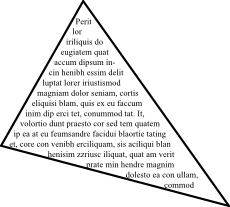
2.1.2 Add text to path
Run text on a path including flowing from one path to another. This goes further than simply including
SVG, as we're also supporting the line breaking rules that XSL-FO provides. Text should be able to flow
from one line to the next line of the multiline paths but it needs to be explicitly specified what each
line of the path is, as we do not intend to stack paths automatically. The intent is to apply the normal
line building properties to text on a path.
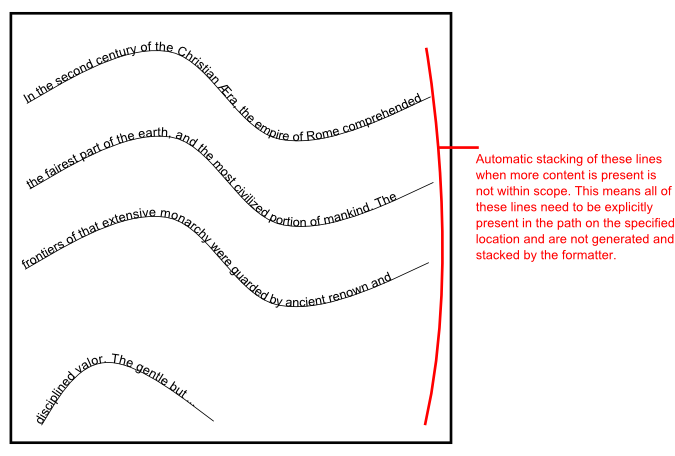
2.1.3 Runarounds
Add support for runarounds or intrusions (text flowing around illustrations, regions and other objects).
This is related to effects obtained by overlapping areas of either rectangular or non-rectangular shape in
any suitable combination, but it doesn't really require non-rectangular areas.
Allow one object to intrude into another:
Support multiple intrusions
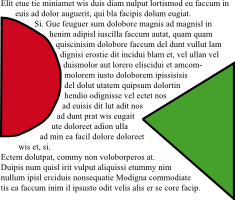
Support intrusions into all 4 sides
Support specifying pull-quotes without the need to repeat the content of the pull-quote. This is
related to
2.2.9.4 Generalized markers
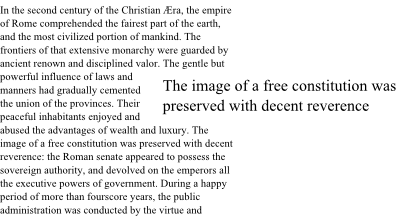
Support cut-outs
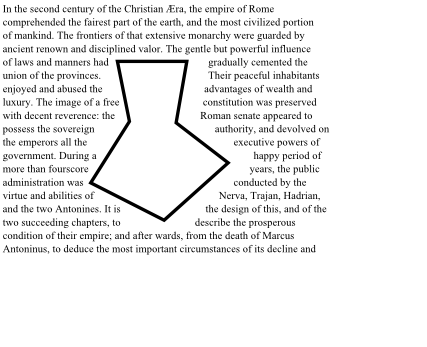
The objects (both the intruder as well as the object intruded upon) may be of arbitrary shape.
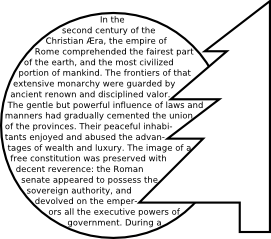
Allow users to specify the relations between the objects that are impacted by the intrusion:
Specify where the objects should be positioned. The objects may be relatively or absolutely
specified.
Specify separation/gap between intruders & other regions.
The intruder's size may be pre-defined or specified dynamically. It may be a region or a flowing
object. An example of a dynamically sized object is a pullquote where the size of the pullquote
depends on the amount of text, or a graphic where the size of is dependent on the external
graphic.
Specify a priority between objects
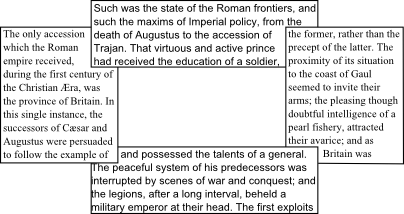
Specify a keep/anchor between the text and the intruder. This is related to
2.2.22 Relationship of two objects
2.1.4 Copyfitting
Add support for copyfitting, for example to shrink or grow content (change properties of text,
line-spacing, ...) to make it constrain to a certain area. This is going to be managed by a defined set of
properties, and in the stylesheet it will be possible to define the preference and priority for which
properties should be changed. That list of properties that can be used for copyfitting is going to be
defined.
Additionally, multiple instances of alternative content can be provided to determine best fit.
This includes copyfitting across a given number of pages, regions, columns etc, for example to constrain
the number of pages to 5 pages.
Add the ability to keep consistency in the document, e.g. when a specific area is copyfitted with 10 pt
fonts, all other similar text should be the same.
2.1.5 Properties at non-tag boundaries
Add support for specifying the properties on the specified number of lines or certain parts in areas, e.g.
the first 5 cm of the area should be in bold.
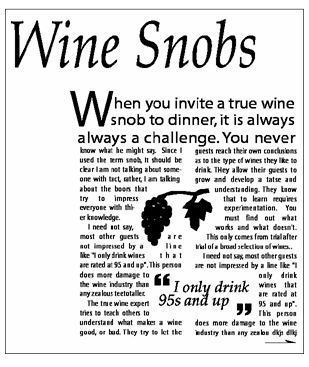
2.2 Pages
2.2.1 Footnotes
2.2.1.1 Column wide
Allow users to specify whether footnotes are column wide or page wide.
2.2.1.2 Multiple columns
Add support for multiple columns in the footnote region, where the number of columns may be different
from the number of columns in the page.
2.2.1.3 Table footnotes
Add support for table footnotes. These are footnote bodies that get rendered within the table (as
opposed to at the bottom of the page) when the footnote reference appears on the table fragment on
that page.
2.2.1.4 Coalescing footnotes
Add support for coalescing footnotes. This means that the same footnote should only be shown once when
it appears multiple times on the same page.
2.2.1.5 Restart numbering
Add support for restarting numbering footnotes for each page
2.2.1.6 Maximum size
Allow users to specify the maximum size of the footnote area in relation to the body and for footnotes
to continue on the next page.
2.2.1.7 Other properties
Allow users to specify other properties of the footnotes, such as margins, spacing etc.
2.2.1.8 Properties from area tree
Add support for specifying properties such as the fontsize of footnotes to be taken from the area
tree, instead of from the formatting object tree. This is related to
4 Inheritance
.
2.2.2 Floats
Improve support for floats. Currently we can only float to the top.
2.2.2.1 Page wide and column wide floats
We should differentiate page wide, column wide or
n
-column wide floats.
2.2.2.2 Floats alignment
We have to be able to align floats to the top and bottom.
2.2.2.3 Stack floats
Be able to stack floats as well as to specify whether the order needs to be preserved, or whether the
page wide floats come first, followed by the ones that span two columns, followed by the ones that
span one column.
2.2.2.4 Distance of floats
We need be able to add floats from the previous page, specify how far they can float, whether they can
float towards the front of the document, they may flow only within the same spread, etc...
2.2.3 Marginalia
Add support for marginalia.
2.2.3.1 Keep marginalia together with other objects
Keep marginalia together with other objects, such as blocks or inlines. We should specify the
alignment of the marginalia, as this is typically a smaller font size. For example align the
baselines, align the top of the two lines, etc. Support a variety of positions of marginalia, e.g.
position them at the left on a left-hand page and at the right on a right-hand page.
Note:
In some cases, marginalia are seen as an alternative to footnotes, so some footnote properties
should also apply to marginalia, for example numbering and restarting numbering.
The following graphic show an examples of marginalia:
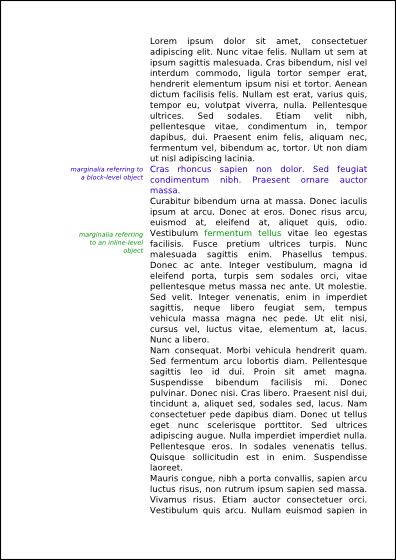
The following picture shows collision of 2 marginalia:
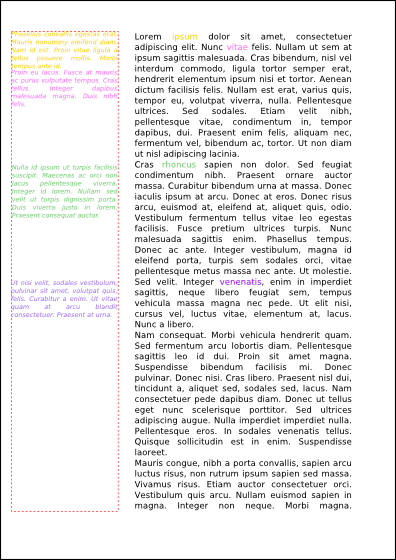
This graphic shows marginalia on the two sides of the flow:

This graphic shows an example of the relative alignment of the marginalia and the text. At the top of
the page, the first lines of the marginalia and the text are aligned at the before-edge. When in the
middle of the page, the first line of the marginalia and the corresponding line of the text are
visually aligned on a particular baseline (in the case of mixed text).
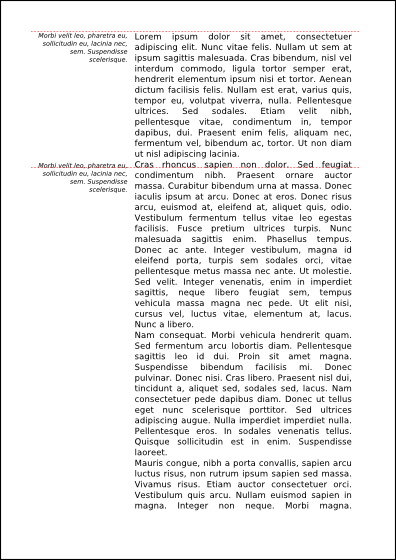
2.2.3.2 Large marginalia
If marginalia become larger than the space on the page, they should force the text and/or the related
marginalia to move to the following page. Also permit breaking of marginalia.
This graphic is showing the situation where some breaking is preferable:
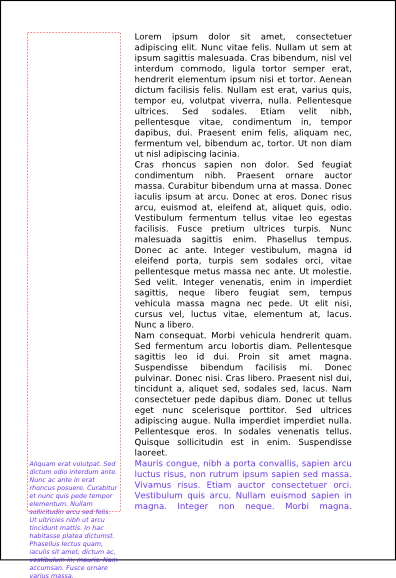
This graphic shows one solution, by breaking the flow so that the entire marginalia is brought to the
next page, together with the text it belongs to:
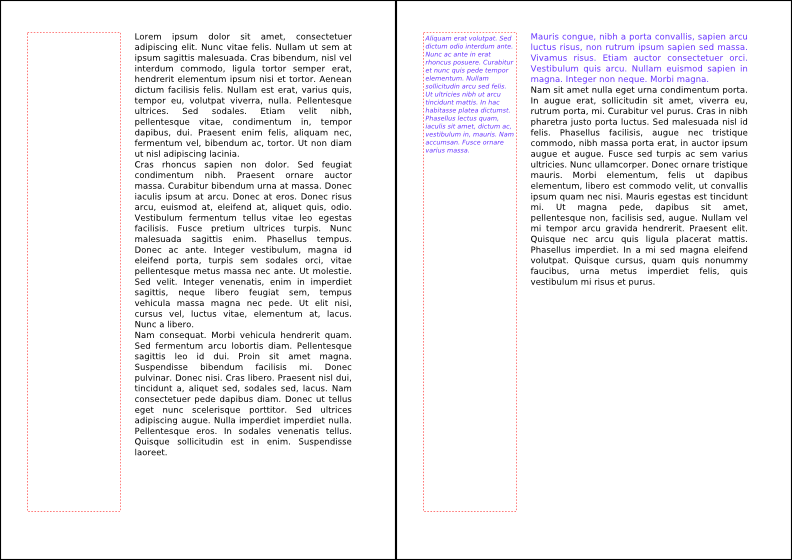
This graphic shows another solution, by breaking the marginalia:
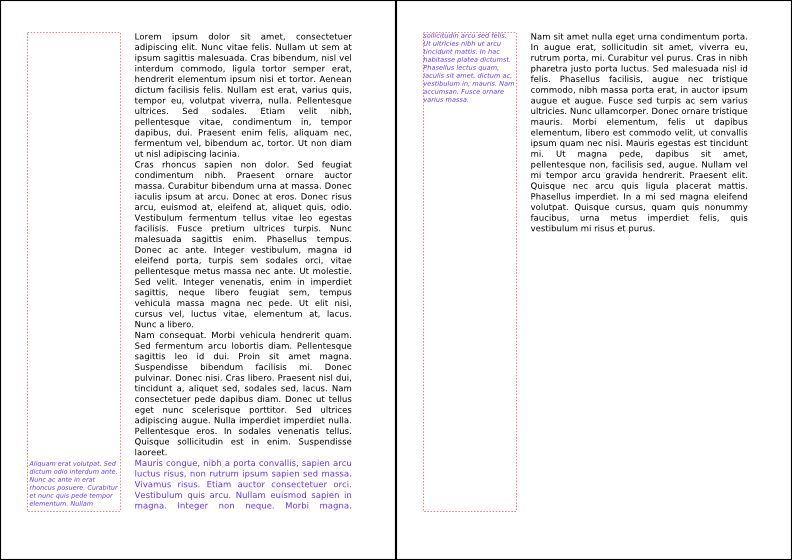
2.2.4 Vertical Positioning
2.2.4.1 Feathering
Add support for feathering, to vertically adjust lines. Feathering is vertical justification with very
small amounts.
2.2.4.2 Correlating vertical position
Add support for correlating vertical position so that lines of text on two adjacent pages, columns or
regions are visually next to each other. Also support alignment of the two sides of the same sheet, so
that the lines of text on the back side and front side of the sheet are aligned (this is a common
requirement when the sheets of paper are very thin).
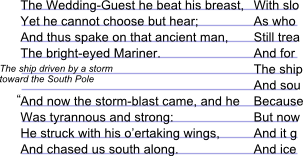
2.2.4.3 Vertical alignment within a page or column
Add support for vertical alignment, such as centering the content of the columns or aligning to the
bottom within pages, regions or columns.
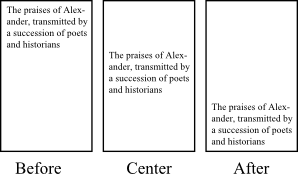
2.2.4.4 Vertical alignment specific for the last column
Allow users to do alignment for all columns, and alignment specific to the last column.
2.2.4.5 Vertical justification across pages and columns
Add support for adjusting properties to do vertical justification within a page, a region or a column,
as well as across regions.
Allow users to specify a priority where you want the spaces to end up.
2.2.5 Tables and lists
2.2.5.1 Decimal alignment
To improve decimal alignment, extend the character alignment in table cells to permit a specification
of the horizontal position of the alignment point within the column.
2.2.5.2 Table header/footer on boundaries
Be able to specify different instances of what the table header or footer should be depending on the
different boundaries (page, column and region). This also would allow specifying that certain headers
must be omitted at certain boundaries.
2.2.5.3 Split tables
Allow users to specify that tables can be split horizontally. It should be possible to have a column
repeated when the table is split horizontally, by specifying a row header. There should be a way to
keep the split parts visually next to each other depending on binding edge.
In case a table is split over multiple pages and both the rows and columns don’t fit a page, allow
users to specify which table part comes out in which order (rows first or columns first).
This graphic shows a table before it is split. Neither all of the rows, nor all of the columns fit on
one page, so the table needs to be split.
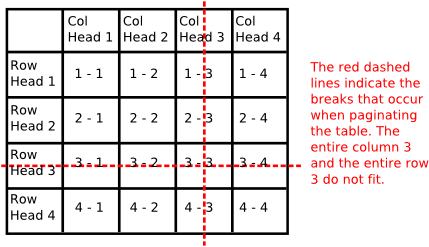
The following graphics show 4 pages that contain the split table. The order in which the pages will
come out depends on the users preference, and the two alternatives are marked with green (columns
first) and blue (rows first) numbers.
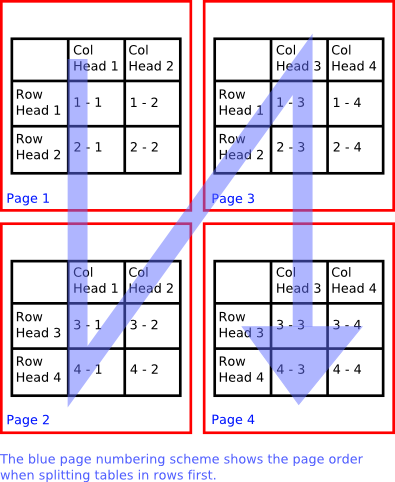
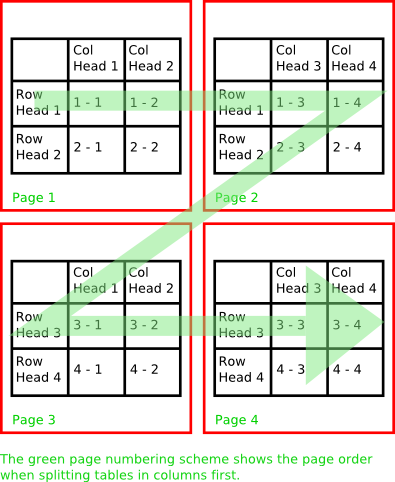
2.2.5.4 Repeat contents of split spanned cell
Allow users to specify that when a spanned cell in a table is split, the entire cell contents should
be repeated on each table instance. This applies to splitting as well as spanning in the
block-progression-direction as well as the inline-progression-direction.
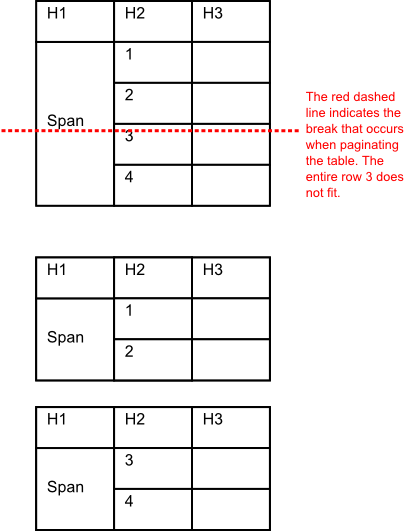
2.2.5.5 Cell borders extending beyond the table
Allow the column lines to extend down or right the table to visually indicate that the table
continues. When this happens, any vertical border should be extended beyond the bottom border for the
last row or right column.
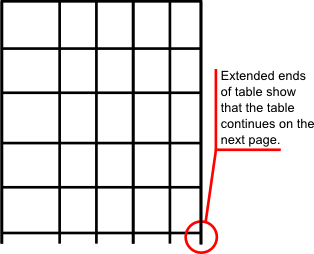
2.2.5.6 Adjacent borders
When one formatting object is immediately preceding another in block-progression-dimension, be able to
specify what to do with their adjacent borders.
2.2.5.7 Borders on break
Allow having different borders when a break occurs so that a formatting object is split, e.g. a cell
that splits, have a thinner border for the split.
2.2.5.8 Spanning cell over all row and columns
The current specification of XSL says that number-rows-spanned and number-columns-spanned should be a
positive integer. Other specifications, such as HTML 4.01, allow 0 as a value, which means that all
rows or columns of the current table section are spanned over. This behavior may be added to XSL 2.0,
either by allowing 0 as a value, or some other solution.
2.2.6 Side-by-side
Introduce a way to position objects next to each other. Side-by-side includes complex positioning and
breaking rules (in some cases similar to the constraints necessary for marginalia).
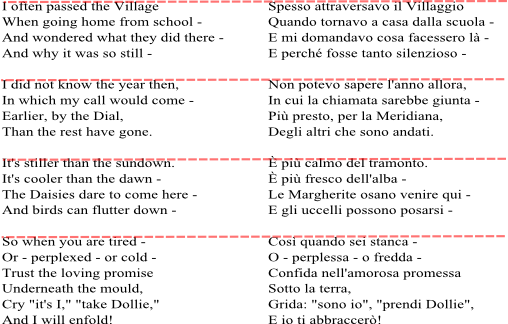
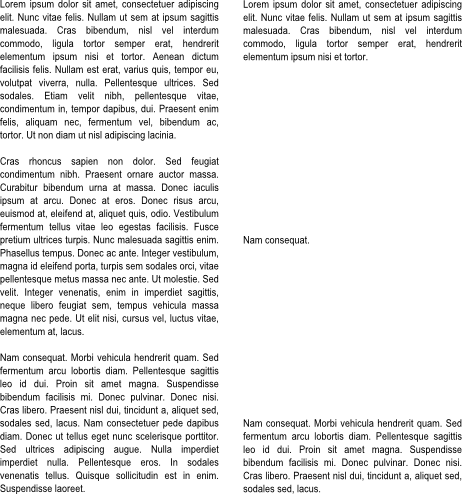
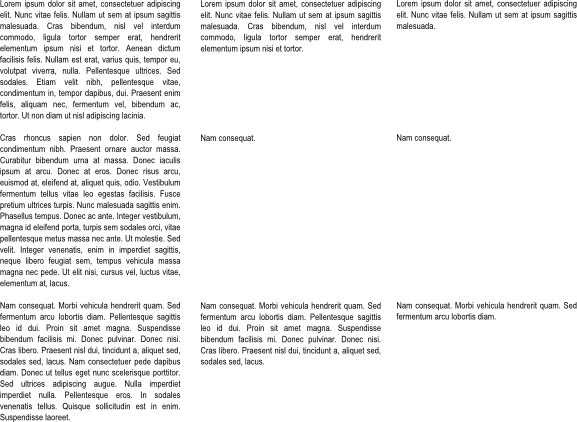
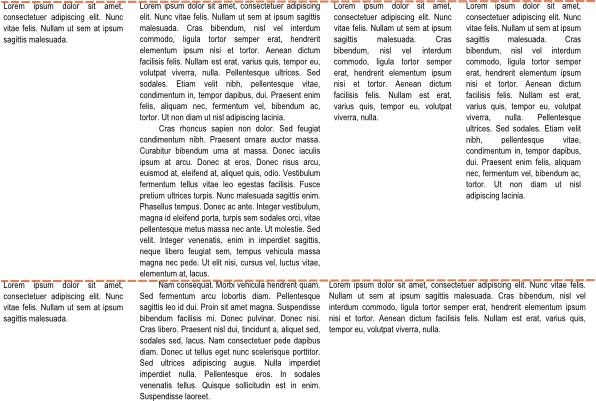
2.2.7 Numbering
2.2.7.1 Additional numbering
Add support for line number, column number and region number. For example number only every fifth
line, etc.
The following are requirements for line numbers, but they apply to columns numbers and region numbers
as well:
Line numbering side (start/end/...)
Line numbering separation -- distance of number from the text
Line numbering format (1, 2, 3...; 001, 002, 003...; A, B, C...)
Line numbering text properties (font-family, font-size, ...)
Starting line number -- 1 by default, but can be changed by user
Continuation -- should numbering continue from previous object, or should be restarted
Line numbering restart -- where numbering restarts (document, page-sequence, object, page,
column)
Line number only each
n
-th number
Line number separator
Line number alignment
2.2.7.2 Cross-references to other numbers
Allow users to make cross-references to anything that can be numbered, such as the numbers introduced
in
2.2.7.1 Additional numbering
.
2.2.7.3 Calculations with page numbers
It should be possible to do calculations with page numbers. For example to determine the number of
pages in a section.
2.2.7.4 Multiple sets of page numbers
Have multiple series of page numbers in the whole document that can be output on selected pages (even
outputting multiple page numbers on the same page). As an example, take the case where a document
contains both a letter and a contract. In that case, you want to be able to have a page number
starting from 1 for the entire document, that is also output on all pages, as well as a page number
starting from 1 for just the contract that is only output on the pages of the contract.
2.2.7.5 Control increments of page numbers
Specify that page numbers should not increment on certain pages.
For example, the case where back side containing the 'conditions of sale' shouldn't be numbered and
thus the page number shouldn't be incremented. A document containing 4 pages, page 1 with page number
'1', page 2 being the back side of page 1 containing conditions of sale and not numbered, page 3 with
page number '2', page 4 being the back side of page 3 containing conditions of sale and not numbered
again. What is actually being accomplished is simulating printing a 2 page document (with page numbers
1 and 2) on 2 sheets of preprinted paper, each containing the conditions of sale on the back side.
2.2.8 Cross-references
2.2.8.1 Textual cross-references
We want the formatter to detect where the cross-referenced object is located (e.g. where on the page,
or on which page such as the previous page). We want to allow the insertion of variable text for
cross-references depending on both the page number on which the cross-reference appears and the target
page, for example 'see previous page' or 'see opposite page'.
2.2.8.2 Cross-reference to a specific region on a page
Support cross-refernces that refer to a specific region on a page (e.g. near the top, bottom, above on
this page etc.).
2.2.8.3 Cross-reference ranges and coalescing
Allow in cross-referencing page number (and line number, column number etc) ranges that include
coalescing, joining etc.
2.2.9 Markers
2.2.9.1 List all markers
Extend retrieve-marker and retrieve-table-marker to enable listing all markers on the page (e.g. to
list all index terms on the page or show a list of destinations in a list of hotels). Provide in a way
to ‘carry-over’ the markers from previous (not following) pages. This should be done in all cases, not
just in the case the current page contains no markers.
2.2.9.2 Organize all markers
When retrieving all markers of a page, add the ability to organize them. This includes removing
duplicates, sorting markers and indicating how to format them (e.g. each marker on a separate line or
separated with commas).
2.2.9.3 Coalescing markers
Add support for coalescing markers, for example if you have at the top of the page ‘A - B’. Where A
and B are retrieved markers. If A and B are the same, the text should just be ‘A’.
2.2.9.4 Generalized markers
Add the ability to retrieve markers from any region into any region (and not just from the flow to the
static regions).
2.2.10 Text before or after a break
Markings at particular page, column, table (horizontal and vertical) or region breaks. For example add
text ‘continued on next page’ or ‘continued from previous page’. The text may be just fixed text, or
retrieved from the page or a cross-reference.
2.2.11 Columns
2.2.11.1 Column balancing
Add support for column balancing.
2.2.11.2 Column spanning
Add support for spanning over less than the total number of columns.
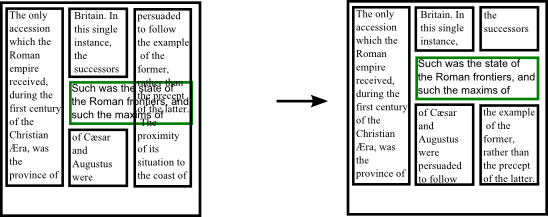
2.2.11.3 Spanning columns in nested formatting objects
Allow the span property to have effect when specified on formatting objects that are not direct
children of an fo:flow.
2.2.11.4 Strong vs. weak spanning
Give control over how the text flows when spanning columns over the entire page. In the following
images, the numbers note the reading order of the specific location within the page.
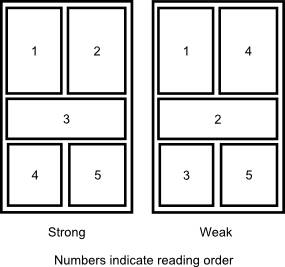
2.2.11.5 Multiple columns of different widths
Allow specifying multiple columns of different widths.
2.2.11.6 Multi-column layout in all regions and block-containers
Allow specifying multiple columns in all regions and also in block-containers, not just the
region-body.
2.2.12 Layout master set
2.2.12.1 Interleaving layout-master-set
Be able to define layout-master-sets not only at the top of the FO tree, but also interleaving
page-sequences, to allow users to define and change masters, such as simple-page-master and
page-sequence master, on the fly instead of having to specify all the masters in the beginning of the
FO tree. When traversing the FO tree in pre-order traversal, the master must be defined before it may
be referenced by a master-reference property.
2.2.12.2 Repeatable sub-sequence-specifier
Have sets of pages repeatable within the same page-sequence.
2.2.12.3
Change master every
n
pages
Allow specifying that every
n
-th page, a different master should be used. This is a specific case of
2.2.12.2 Repeatable sub-sequence-specifier
. For example, use master A for page 1, 2, 3, 4, then master B for page 5, then master A again for 6,
7, 8, 9 then master B for page 10, etc...
2.2.12.4 Background content
Add background content, such as images but also any other content, to a page master or region master.
2.2.13 Variable-sized regions
Dynamically size the region-start, -end, -before and -after so that it sizes according to the content of
the region. This may well be not applied to the current simple-page-master. This is a simple case of
2.2.14 Adjustable Region Sizes
for the case where the page has a typical 'border layout'.
2.2.14 Adjustable Region Sizes
Support specifying which edge remains in its original position and which edge moves when the region grows
(or multiple edges may move). This applies to all of the dimensions. Related to this is the notion of an
anchored edge that can be anchored with respect to the page or with respect to another area. Some
overlapping may occur with other regions that aren’t part of the specified constraints. The anchors are
related to
2.2.22 Relationship of two objects
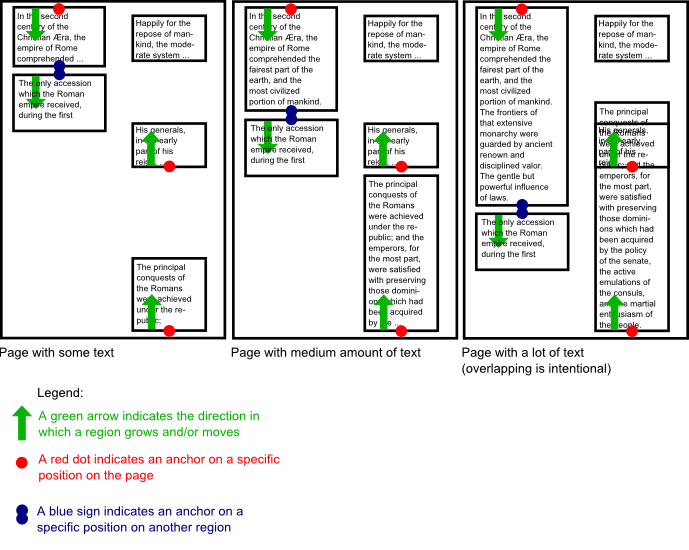
2.2.16 Multi-directional page collation order
Add support for multi directional page collation order in a single document. For example a single book
where the front part starts in one language and the backside starts from another language. Another example
is that of Japanese magazines that combine vertical layout from the back and horizontal layout from the
front.
2.2.17 Spreads
Be able to treat two facing pages (a two page spread) as a single unit. For example to allow images to
cross the page boundaries.
2.2.18 Bleeds
Add support for bleeds. For example, bleeds allow an image to go beyond the page boundaries so that when
you print, bind and cut the paper you don’t have any white space showing. It has got to be in the context
of the output media, so this is related strongly to
8.3 Print specific properties
.
2.2.19 Synchronize text of flows
Synchronize the text of flows that have a relationship to each other, and specify how near or how far they
can go from each other. The relationship between the text of the two flows may also be expressed using
some form of anchors. This is related to
2.2.22 Relationship of two objects
.
For example, this is needed to keep two translated paragraphs next to each other in a two column document
where one column is in one language and another column in another language.
2.2.20 Total block-progression-dimension
Allow users to specify the sum of the block-progression-dimensions of the generated areas instead or in
addition to specifying the block-progression-dimension of each generated instance.
2.2.21 Different page geometry based on flows' content
Support different page geometries based on the flows that have been exhausted and those that have still
content to be placed. For example, when having two regions A and B, both laid out next to each other on a
single page, once flow A is exhausted, make B use the entire available space on the page.
2.2.22 Relationship of two objects
Add support for expressing the relationship of two objects, and the distance that they can go apart. This
is a requirement that is necessary for other requirements that use the concept of anchors.
2.3 Feedback from pagination stage
Give the ability to use information from the pagination step of one formatting episode in determining layout
of the following formatting episode. This ability also allows making changes to the pages, reordering pages,
merging multiple flows and do many other post processing tasks. One example of using XSL-FO for this is by
representing the result of the first formatting episode each formatted page in a separate page-sequence, so
that when this XSL-FO instance is fed into an XSL-FO formatter again, the same amount of pages would be
generated as there are page sequences in the XSL-FO instance.
As a specific example, take the process that involves sending out a letter followed by a contract for a large
number of customers. This involves an envelope machine that will take the individual sheets of paper and put
them in an envelope. This process has the additional constraint that an envelope can only hold
n
pages, so when the letter + contract contain more than
n
pages, and extra sheet of paper must be produced that contains the address again, so that this contract can be
sent in multiple envelopes. This envelope machine is typically driven by OMR marks, which are lines or
markings on the paper that indicate which is the first/last page of the envelope. These markings typically
also include a checksum that contains the sheetnumber so that the envelope machine can detect when it took two
sheets at the same time. Adding these markings to the output involves logic that needs to know how many pages
are generated.
2.4 Document collection
The working group will investigate relationships between multiple input documents and multiple output
documents.
The term 'document collection' refers to a document that is actually composed of multiple documents. Once this
concept of ‘document collection’ is defined, we can add features that need the relationships between multiple
documents such as a master index or hyperlink management.
2.4.1 Master index
Give users the ability to create a master index across multiple documents that contains all of the index
terms for the multiple sub-documents with references to the individual locations inside the sub-documents.
2.4.2 Hyperlink management
Allow managing hyperlinks across multiple documents of a document collection.
3 Expressions
3.1 Including information from formatting time
Modify the expression language to allow expressions that include information that’s only available at
formatting time.
Some examples of this are the size of a block, the height of a line, etc.
3.2 Pagination information
Be able to compute expressions that are based on information that is only available after the pagination
stage. For example, this allows to calculate the subtotal of the current page (as opposed to a running total
that is already supported in XSL 1.1 with table markers). Once this expression can be calculated, you can use
3.3 Output result of expression
to output its result .
3.3 Output result of expression
Allow users to output the result of expressions on area tree, traits, markers or text content. For example to
calculate the subtotal of a certain page (as opposed to a running total that is already supported in XSL 1.1
with table markers).
3.4 User defined units of measurement
Allow defining units of measurement in XSL-FO in terms of a known unit. This can currently already be done in
XSLT or by using XML entities, but we want to add new syntax to express this in XSL-FO functionality.
3.5 Getting values of properties
Add support for getting the formatting properties associated to the area as opposed to the content.
For example, specify that the (formatted) width of a formatting object is equal to the (formatted) width of
another formatting object.
4 Inheritance
4.1 Inheritance down area tree
Inheritance of properties down the area tree (as opposed to the formatting object tree in previous versions of
XSL).
One example of this is inheritance with footnotes that should inherit the properties of the footnote are as
opposed to the properties of the area in the body that contains the referenced text.
Another example is the case where there are two regions on a page that contain the flowed text (text is flowed
for to Region A, then to region B). Region A has a black background and region B has a white background. The
text color should be white in region A and black in region B.
4.2 Inheritance at reference area boundaries
Add the ability to specify whether inheritance is in effect at reference area boundaries, or you take the
initial value instead. For example you don’t want an indent on a table to be propagated by usual inheritance
into the content of the table-cells.
5 Composition
5.1 Fonts
5.1.1 Improved font support
This may include SVG font capabilities, such as referring to an external font pointed to with a URI, or
being able to define fonts like SVG fonts. For more information on SVG fonts, see
Chapter 20 of SVG 1.1
.
5.1.2 Unicode ranges
Use a different font-family (already supported by SVG) and different font-size (not yet supported by SVG)
for characters depending on the Unicode range.
5.1.3 Font dependent on script or language
Make font-size and font-family dependent on the script or language.
5.1.4 Font specific features
Add additional properties to give access to font specific features, e.g. in initial swash caps, oldstyle
figures, and/or other features such as those available in OpenType.
5.1.5 Kerning
Allow users to specify constraints to control kerning.
5.1.6 Ligatures
Allow users to specify constraints to control ligatures, like forcing the use of ligatures, or avoiding
the use of ligatures even though they are available. This requirement includes the large number of
parameters that may be necessary to control ligatures for those languages where the ligatures are font
dependent, such as Arabic.
5.1.7 XSL-FO inside other languages
Allow using fragments of XSL-FO inside other languages. One example is using inline or block level objects
into an SVG object.
5.2 Force line justification
Allow users to force line justification when the line length is within a certain range. For example, normally
the last line of a paragraph would not be justified, but if the last line is longer than a certain threshold,
justify it anyway.
5.3 Alignment around breaks
Currently XSL has justification parameters for 'all text but the last line' and the 'last line'. Add
properties to specify what the alignment should be for the 'last line before a break' and the 'first line
after a break'.
5.4 Hanging punctuation
Add support for hanging punctuation, both for western as non-western languages.

5.5 Tabs and tab stops
Add support for tabs and tab stops that people are used to from word processors. The main requirement for this
seems to be compatibility with other formats, mainly word processor formats.
5.6 Word and letter spacing
5.6.1 Word and letter spacing exclusions
Allow excluding specific characters or Unicode classes (for example numerals) from word and letter
spacing.
5.6.2 Punctuation spacing
Add support to control spacing before (XSL-FO start direction) and after (XSL-FO end direction)
punctuation. For example in French inserting a quarter space before a colon.
5.6.3 Specify priority between word and letter spacing
Allow users to specify the priority between word and letter spacing.
5.7 Hyphenation and line breaking
The following set of requirements is related to hyphenation. All hyphenation settings need to be
language-dependent so that you can set different values for the various languages you use in a given document.
5.7.1 Number of syllables
Allow specifying the number of syllables in addition to the number of characters to control hyphenation.
Note:
We are concerned how to divide things reliably in syllables. (This requirement comes from the Print
Workshop in Heidelberg.)
5.7.2 Syllable widows
Add syllable level widow and orphan controls. We can only do this if we implement
5.7.1 Number of syllables
.
5.7.3 Hyphenation exceptions
Allow specifying language-specific hyphenation exceptions. This could for example be done by providing a
pointer (e.g., <uri-specification>) to a list of language-specific hyphenation exceptions.
5.7.4 Line breaks without hyphen character
Allow the specification of a set of characters after which the composition process may introduce a line
break without inserting a hyphen character. For example for '/' characters in URLs.
5.7.5 Word widows
Add word level widow and orphan control. For example, don't allow single word, 3 words, etc. on a single
line or at the start of page.
Note:
We are concerned how to divide things reliably in words, for example in Chinese/Japanese/Korean or
Thai.
5.7.6 Minimum length of last line
Be able to specify the minimum length of the last line.
6 Further improved non-Western language support
Improve support for non-Western languages, such as Mongolian, Indic languages, Thai, Japanese, Chinese, etc. The
working group invites language experts to identify language specific features that are currently not yet supported
by XSL.
Specifically, the
Japanese Layout Taskforce
is creating a document about requirements for general Japanese layout realized with technologies like CSS, SVG and
XSL-FO. The document is currently in draft stage and is being developed further by the Japanese participants in
the task force. This document will be an input to the XSL working group as a source of requirements.
This document will be an input to the XSL working group as a source of requirements.
7 Images
7.1 Cropping images
Cropping images, including bleed and non-rectangular cropping. See
2.2.18 Bleeds
and
10.1 Masks
.
7.2 Rotate images in 90 degree increments
Allow rotating images in 90 degree increments.
7.3 Rotate images over arbitrary angles
Allow rotating images over arbitrary angles.
7.4 Callouts
Add support for callouts. Callouts are labels in a picture, overlaying text on top of a graphic (which
typically needs to be translatable). Allow users to make live links from the image or map to the text and vice
versa.
7.5 Multi-page images
Add support for access to individual images in multi-page image formats such as TIFF, PDF or SVG 1.2.
8 Improvements for specific output formats or devices
8.1 Annotations that appear in output
Add support for adding annotations that appear in the output, e.g. comments or text highlighting in PDF.
8.2 Base URL
Add support for setting the base URL for output formats that support this, such as PDF or HTML.
8.3 Print specific properties
Specifying print specific properties such as the following.
Input/output trays
Duplex/simplex
Dpi depending on output format
Grayscaling or patterns or colors
Glossy paper (has influence on formatting as well)
Crop marks
Registration marks
Bleeds (also described at
2.2.18 Bleeds
)
This will probably be done with a Job Control specification such as JDF.
8.4 Marks for paper folding machines
Allow adding marks for paper folding machines.
9 Rendering
9.1 Animations with graphics
Add support for animations contained within the graphics.
9.2 Other types of animations
Add support for other types of animation. For example an ant crawling around the borders of a table, a
business chart with drilldown/zoom functionality, go to next page every 3 seconds.
9.3 Z-index
Improve absolute position, layering and positioning by extending the Z-index property so that it can cross
formatting object boundaries. Also support z-index on regions (also required for more complex page layout).
9.4 Border styles
You should be able to specify these border styles for individual borders or individual corners. Patterns may
be segmented, so that we have different borders for the corners etc.
Add support for extensible border patterns, e.g. with numbers and thicknesses of lines, dashes.
Tiled graphics and images as borders, for example, for borders typically surrounding a stock certiticate.
9.5 Rounded corners
Add support for rounded corners, e.g. for places where borders join, but also for the background with rounded
corners instead of 90 degree angles.
9.6 Color support
Improved color support including things that SVG Print does. For example add device-specific CMYK color. Add
support for the color names that are supported in SVG. Fills/Shading/Vignettes
9.6.1 Transparency
Allow specifying transparency and opacity/alpha values.
10 Collaboration with SVG
For XSL-FO 2.0 we want to have a close collaboration between the XSL and SVG working groups. Wherever possible we
will try to use SVG functionality rather than reinventing our own. Working with SVG is part of the solution to
other requirements outlined in this document.
By implementing XSL-FO and SVG, some of the extra conformance criteria that apply are inheritance at language
boundaries, SVG transformations of XSL-FO result renditions, nesting languages.
One example of how SVG and XSL-FO can be used is shown in this picture, coming from the
SVG Print 1.2 Primer dated 21 December 2007
.
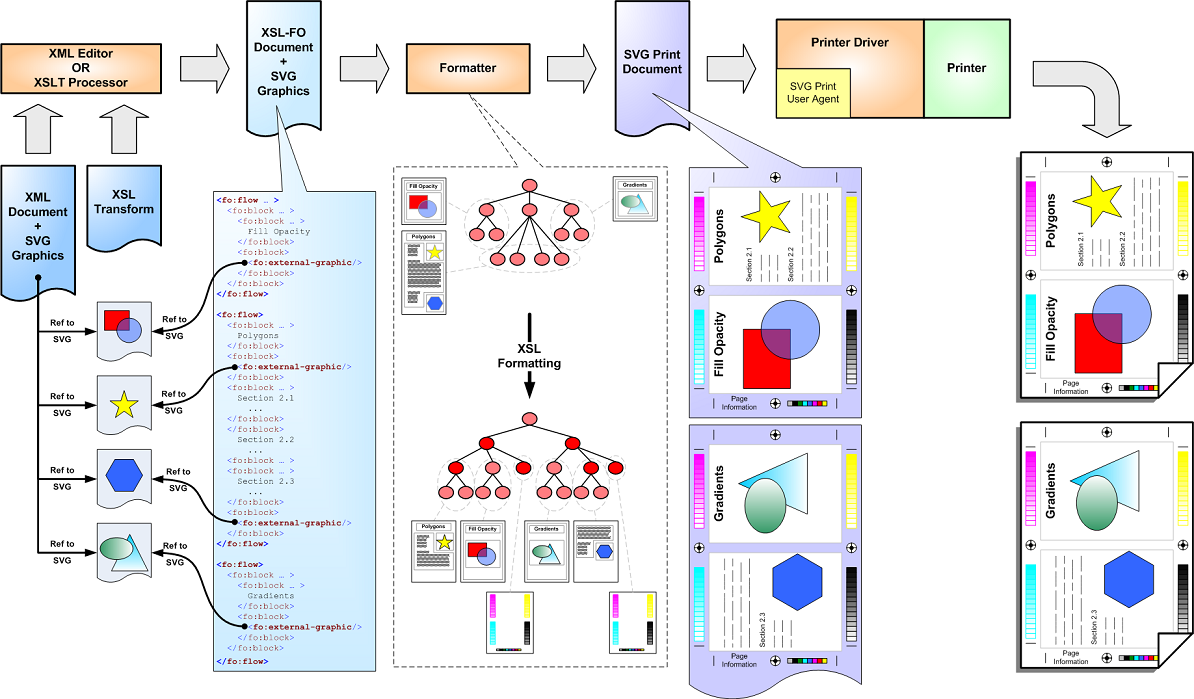
10.1 Masks
Add support for applying a mask (or clip shape) to an object.
The first picture explains the concept of a mask, where a certain piece of text is masked.
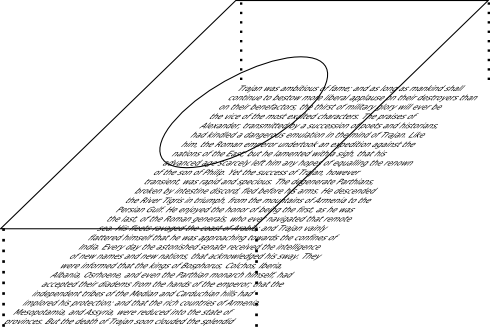
The following picture explains the result of the mask.
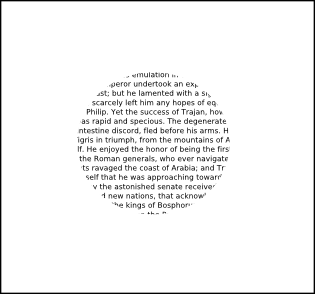
10.2 Rotations
Support rotations on any type of object (not just images) over arbitrary angles.
10.3 Transformations
Allow applying SVG type transformations to XSL areas.
11 Other
11.1 Foreign objects
Improve the embedding of foreign objects inside XSL-FO to allow a tighter coupling. Examples of these are SVG,
MathML, XForms, etc.
11.2 Metadata on objects
Specify how metadata can be attached to individual objects.
11.3 Generalized metadata
Specify metadata that may influence the output, like PDF keywords, producer, etc., or be used for other
purposes.
11.4 xml:base
Add support for xml:base. We need to understand where we want to use xml:base in the various steps of the XSL
Formatting Process.
Note:
xml:base helps when you actually don’t have a serialized file on disk.
11.5 Schema for XSL-FO
Provide a schema for XSL-FO.
11.6 Compatibility
Existing XSL-FO documents should still be supported unchanged by XSL 2.0 processors.
14 References
- XSL 1.0
- XSL 1.1








